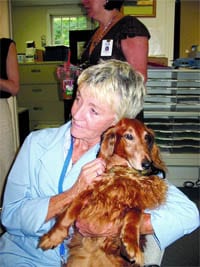The Issue Is Recruitment Area Providers Say They Must Generate New Interest In Health Care Careers
The Sisters of Providence Health System (SPHS) has a new program that pays employees $1 for each hour of work turned in by a nurse they help recruit.
An enterprising individual who recruits three nurses who wind up working full time, for example, can take home an additional $6,240 over the next year.
That may sound like an extreme — and expensive — step for a health care system to take, but it’s quite necessary, and it’s only one of many strategies being deployed, said Vincent McCorkle, president and CEO of the SPHS and Mercy Medical Center in Springfield. And it’s also less expensive than many of the alternatives, such as hiring nurses from agencies or using other types of recruiters.
Extreme measures such as this are part of the cost of doing business in a changing environment in health care, say administrators who spoke with The Healthcare News. A number of societal and demographic factors make current shortages in a broad range of fields far different than the cyclical shortages that providers have seen in the past.
In other words, the current set of challenges is anything but temporary.
Indeed, what the health care sector is seeing now is a unique set of circumstances that will make the recruitment and retention of qualified professionals perhaps the most pressing issue for providers in 2002 and well beyond, said Michael Daly, president and CEO of Baystate Health System.
“Workforce issues are right at the top of our list of priorities,” said Daly, who added that his system — and all others — are adjusting to a new way of life.
Hospitals and other providers have always had to recruit, said Hank Porten, president of Holyoke Hospital, but today they must work to ensure a strong, reliable workforce for both the short and long term. And this means working with schools at every level to build interest in health care careers.
“What we need is a jump start, and state and federal governments can help with scholarships, grants, and other types of incentives,” he said. “Individual hospitals can’t do much, if anything, to turn this around themselves.”
Going into Labor
Only a few years ago, nurses would generally work their entire career at the same hospital, said Diane Brunelle, assistant vice president of nursing at Holyoke Hospital. All that has changed in recent years as the competition for nurses has heated up and individuals in that field find themselves in demand.
“We’re seeing a lot more movement than we did years ago,” she explained. “Money has a lot to do with this — it’s a very competitive environment — and you see a lot of nurses looking for better deals because they are out there.”
It’s like that in a number of health care professions, said McCorkle, and it’s especially true with physicians, who can, by crossing a state line, often dramatically improve their earning capacity.
All this puts area hospitals, especially smaller community facilities, in a difficult position. They must now expend more time and resources recruiting and retaining good help at a time when they don’t have surpluses of either.
“These individuals know they’re in high demand, and thus they can move from employer to employer,” said McCorkle. “This puts us in a position where we have to adjust.”
For example, the system has added more than $2 million in total salaries and benefits this fiscal year — in addition to what would be considered typical annual increases to adjust to changes in the marketplace.
“Traditionally, those annual increases have kept most people competitive, but not in the current environment,” he said. “It’s hard to find an additional $2 million to put into salary and benefits, but we need to be the employer of choice, and to do that we need to improve salary and benefits.”
But Daly, whose hospital is in a position to pay more, says that in many cases, money isn’t the answer, especially for nurses.
“Many nurses are looking for improvement in quality-of-life issues,” he said, listing hours of work as one of the primary concerns. To that end, the hospital has embarked on a program to recruit nurses with a particular interest in working nights or weekends. This would allow the system to be more flexible with some of its other nurses.
Brunelle concurred, noting that a growing number of nurses are opting to work with agencies that provide nurses and other professionals to health care providers.
The money is better, she said, and there is often more flexibility in assignments.
The problem facing hospitals and other providers is one of numbers, she explained, noting that all facilities in the area are recruiting from largely the same pool of working nurses and recent graduates — and that pool isn’t getting any bigger.
In fact, it’s getting smaller. The number of new nurses entering the field is not keeping pace with those retiring or leaving the profession, she said. Projections show that by the year 2020, there will be 20{06cf2b9696b159f874511d23dbc893eb1ac83014175ed30550cfff22781411e5} fewer nurses, at a time when demand will be much greater than it is today.
Facing this grim reality, hospitals must address the situation from the both short- and long-term perspectives.
Daly said Baystate had perhaps its best recruiting year ever in 2001, adding about 80 nurses, 30 more than the original goal. “From a numbers perspective, that’s good news,” he said, “but from a needs perspective, it isn’t quite as good because new graduates are not prepared to go into the fields where the need is greatest, like critical care and pediatric intensive care.”
Still, the young nurses are to be viewed as a sound investment, he said, adding that in a few years they will develop the skills needed to handle those more challenging assignments.
And while nurses are gaining most of the attention in the ongoing recruitment challenge, the problem is much more systemic, said those who spoke with The Healthcare News. The shortage of pharmacists is particularly acute, while hospitals have also had difficulties recruiting a number of specialists, from nuclear medicine technicians to occupational and physical therapists.
For these problems there are no short-term solutions, Porten stressed, adding that to bring some measure of relief long-term, hospitals and other care providers must play a leading role in efforts to make health care professions more attractive to young people.
Work in Progress
But providers certainly can’t handle this assignment alone, he stressed, adding that state and federal governments have to help provide that jump-start he said is so critical. There had been some movement in this direction, especially in efforts to recruit more nurses, said Porten; however, the events of 9/11 have altered the Congressional agenda and stifled some of the momentum that had been built up.
“We need both young individuals and second-career people to look more favorably upon careers in health care,” he said, “and then we need scholarships, loan-forgiveness programs, and other types of incentives.”
The terrorist attacks of Sept. 11 may actually help this cause in some ways, he noted. The disasters have cast service professions — police, fire, and, to a lesser extent, medical personnel — in a new, more favorable light.
“More young people are now looking at those service professions and saying, ‘these are valuable people,’” he said. “We have to build on this and continue to promote these types of jobs.”
Still, even with some type of jump start from state and federal governments, it will take many years to build up the types of numbers that health care providers need, he said.
“It takes sometimes five, six years, or more to attain the talents needed for some of these professions,” he said. “You can’t just flip a switch and create more nurses or pharmacists.”
So for the short term, hospitals and other care providers will continue to adjust to a new way of life, said McCorkle, who said the SPHS has developed some 40 programs to help attract and retain nurses and other professionals.
“Recruiting and retaining qualified professionals is a critical issue for all providers,” he said. “And it’s going to be with us for a long, long time.”




